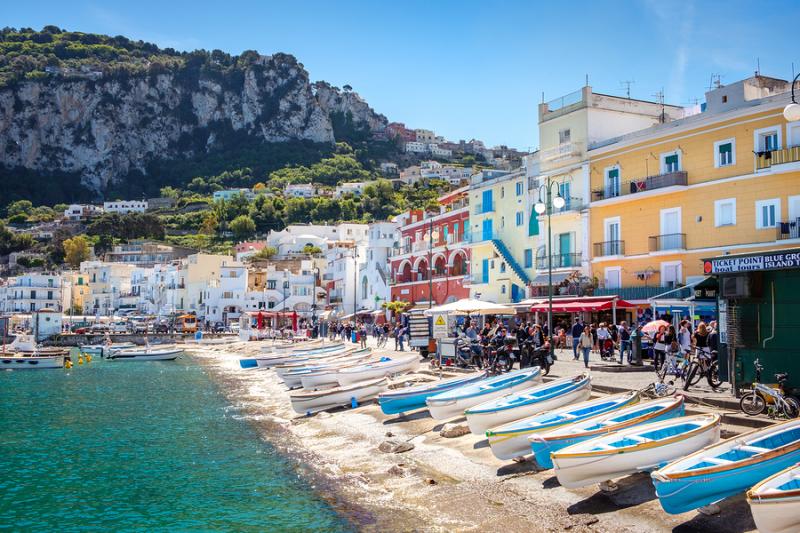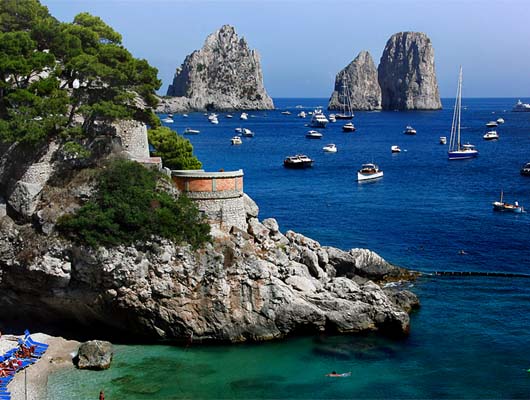Dual Language Article - Magical Capri
ITA:

Magical Capri, which Jean Paul Sartre defined "Island" with capital "I", seems immutable in time, a stupendous pearl mounted as a jewel upon the sea. A tiny plot of land that marks the entrance to the gulf of Naples, with peaks and cliffs jutting over the sea. The faraglioni, two superb boulders, emerge from the water just a few meters from the coast. Legend has it that the giant Cyclops, mythical figures settled on Capri by the gods, had flung those huge masses against the Greek and Phoenician ships that wanted to profane their secrets.
Indeed, the first to appreciate the marvels of Capri were the Greeks and the Phoenicians, but it was the Romans, more than others, who left their mark. Emperor Augustus first and Tiberius later were enchanted by the island. Tiberius turned it into a sort of personal kingdom where he spent a good eleven years of his life. The two emperors can be credited with having constructed building and roads. Some remains can still be seen such as the Augustan gardens with the famous belvedere, a window that opens onto a fairytale scene.
"Modern" Capri, the first actual town, dates back to the thirteenth century when frequent pirate incursions convinced the islanders to build a fort precisely where the piazzetta is today, in order to
control the port area. The first houses began to spring op around the fort. The most recent style of the island, a style which is quite similar to today's appearance, is characterised by villas suspended on the rock cliffs between the sky and the sea and dates back to the beginning of the twentieth century when the lovers of Liberty and subsequently of the Belle Epoque, brought their protagonism to Capri, their characters and dynasties. The last of the Hapsburgs and the first nouveau-riche like the Thyssen, the Pirellis and the Agnellis. Today, just like in the times of Hemingway, Malaparte, Faruk, Onassis, when at sunset the "piazzetta" (Piazza Umberto I) becomes a salon, animated by thousands of guests, all seated at tables at the "Gran Caffè" Vuotto" with the classic glass of chilled white wine.
Alleys paved with ancient pastel-grey cobblestones branch out from the famous "piazzetta", the heart of the island. And beneath the arched porticoes made of dark volcanic stone, the most exclusive shops which sell colourful silk blouses, mid-calf pants and hand-made sandals, all symbols around the world of the informal famous fashion known as the "Capri style".
The pants were a creation of fashion designer Sonja de Lennart in 1948 and they were first made popular in Capri in the late 1950s and early 1960s. Later they became also popular in the United States during the 1960s and woderful movie star Audrey Hepburn made them famous in movies like Sabrina, Funny Face and Breakfast at Tiffany's. After a drop in popularity between the 1970s and 1990s, today Capri pants are back in fashion. Capri sandals are hand-made in soft leather and decorated with exquisite pieces of costume jewelry. Like the famous pants, the sandals have been purchased by customers of international fame such as Principessa Margaret, Soraya, Maria Callas, Sofia Loren, Anita Ekberg, Naomi Campbell and many others.
Sun, sea, good food and nights stretching until dawn, among the muffled notes and lights of the nightclubs. And so, on this magical island, love stories intertwine and dissolve again, every day and every night one hundred stories are born and die, like a mid-summer's dream of a Capri night.

La magica capri, che Jean Paul Sartre definì "Isola" con la "I" maiuscola, sembra immutabile nel tempo, una perla preziosa incastonata nel mare. L'isola è un fazzoletto di terra che segna l'ingresso nel Golfo di Napoli, con picchi e rocce a strapiombo sul mare. I Faraglioni, due rocce altere e superbe, spuntano dall'acqua a pochi metri dalla costa. Secondo la leggenda, furono i Ciclopi, mitiche figure di giganti insediati a Capri dagli Dei, a scagliare quegli enormi massi contro le navi greche e fenicie che volevano profanare i loro segreti.
Infatti, i primi ad apprezzare le meraviglie di capri furono i Greci ed i Fenici, ma i Romani, più di altri, lasciarono la loro impronta. Prima l'imperatore Augusto e poi Tiberio rimasero affascinati dall'isola. Tiberio ne fece una specie di regno personale, dove trascorse ben undici anni della sua vita. Ai due imperatori romani, si deve la costruzione di edifici e strade, dei quali alcuni sono ancora ben visibili: come i giardini di augusto, con il famoso belvedere, davvero una finestra aperta su uno scenario di favola.
La prima struttura cittadina vera e propria della Capri "moderna" risale al 1200, quando le frequenti incursioni dei pirati convinsero gli abitanti a costruire una rocca, proprio dove oggi si apre la famosa piazzetta, per tenere sotto controllo la zona del porto e intorno alla rocca fiorirono le prime case. L'ultimo volto dell'isola, un volto abbastanza simile a quello di oggi, caratterizzato dalle ville sospese sulla roccia, tra cielo e mare, risale al secolo scorso con gli amanti del Liberty, e poi della Belle Epoque, che portò a Capri i suoi grandi protagonisti, personaggi e dinastie. Gli ultimi Asburgo e i primi nuovi ricchi come i Thyssen, i Pirelli e gli Agnelli. Ancora oggi, proprio come accadeva ai tempi di Hemingway, di Malaparte, di Faruk, di Onassis, al calar del sole la piazzetta (Piazza Umberto I) diventa un salotto animato da mille ospiti: tutti seduti ai tavoli del Gran Caffè Vuotto con il classico aperitivo di vino bianco ghiacciato.
Dalla piazzetta, cuore dell'isola, si diramano i viottoli lastricati di pietra antica, grigio pastello. E sotto i portici dalle arcate in roccia vulcanica, si trovano i piccoli negozi più esclusivi che vendono quei capi d' abbigliamento, bluse in seta colorate, pantaloncini a metà polpaccio, sandali fatti a mano, simboli nel mondo di una moda informale e famosissima: lo "stile Capri".
I pantaloni furono creati dalla designer Sonja de Lennart nel 1948 ed inizialmente divennero popolari proprio a Capri verso la fine degli anni '50 e i primi anni '60. Più tardi divennero popolari anche negli Stati Uniti negli anni '60 e la favolosa star del cinema Audrey Hepburn li rese famosi in film come Sabrina, Cenerentola a Parigi e Colazione da Tiffany. Dopo un calo di popolarità durante gli anni '70 fino agli anni '90, i pantaloni Capri sono oggi tornati di moda. I sandali capresi sono fatti a mano usando del cuoio morbido e sono decorati con raffinati elementi di bigiotteria. Come i famosi pantaloni, i sandali sono stati acquistati da clienti di fama internazionale come la Principessa Margaret, Soraya, Maria Callas, Sofia Loren, Anita Ekberg, Naomi Campbell e molti altri ancora.
Sole, mare, buona cucina e notti tirate fino all'alba, tra le note e le luci ovattate dei locali notturni. Così in quest'isola magica, gli amori si intrecciano e si sciolgono, ogni giorno e ogni notte nascono e muoiono cento storie, nel sogno di una notte caprese di mezza estate.











